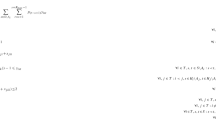Abstract
This paper proposes a new approach to the well-known Liu–Layland periodic scheduling problem. This approach proves that any just-in-time sequence with maximum absolute deviation being less than one is in fact a periodic schedule. Consequently, periodic schedules can be obtained by any algorithm capable of generating just-in-time sequences with maximum absolute deviation being less than one, for instance, any algorithm minimizing maximum deviation or the quota methods of apportionment.
Similar content being viewed by others
References
Balinski, M. and H. P. Young, “The quota method of apportionment,” American Mathematics Monthly, 82, 701–730 (1975).
Blazewicz, J., K. Ecker, E. Pesch, G. Schmidt, and J. Weglarz, Scheduling Computer and Manufacturing Processes, 2nd edition, Springer, Berlin, 1996.
Bratley, P., M. Florian, and P. Robillard, “Scheduling with earliest start and due date constraints,” Naval Research Logistics Quarterly, 18, 511–517 (1971).
Brauner, N. and Y. Crama, “The maximum deviation just-in-time scheduling problem,” Discrete Applied Mathematics, 134, 25–50 (2004).
Brauner, N., V. Jost, and W. Kubiak, “On symmetric Fraenkel’s and small deviations conjectures,” Les cahiers du Laboratoire Leibniz-IMAG, no 54, Grenoble, France, 2002.
Buttazzo, G. C., Predictable Scheduling Algorithms and Applications, Hard Real-Time Computing Systems, Kluwer Academic Publishers, Dordrecht, 1997.
Dertouzos, M., “Control Robotics: The procedural control of physical processes,” in Proceedings of IFIP Congress, 1974, pp. 807–813.
Devillers, R. and J. Goossens, “Liu and Layland’s schedulability test revisited,” Information Processing Letters, 73, 157–161 (2000).
Glover, F., “Maximum matching in a convex bipartite graph,” Naval Research Logistics Quarterly, 4, 313–316 (1967).
Kubiak, W., “On small deviations conjecture,” Bulletin of the Polish Academy of Sciences, 51, 189–203 (2003).
Kubiak, W. and S. P. Sethi, “A Note on ‘Level schedules for mixed-model assembly lines in just-in-time production systems,” Management Science, 37, 121–122 (1991).
Kubiak, W. and S. P. Sethi “Optimal just-in-time schedules for flexible transfer lines,” The International Journal of Flexible Manufacturing Systems, 6, 137–154 (1994).
Lawler, E., Combinatorial Optimization. Networks and Matroids, Holt, Rinehart & Winston, New York, 1976.
Liu, C. L. and J. W. Layland, “Scheduling algorithm for multiprogramming in a hard real-time environment,” Journal of ACM, 20, 46–61 (1973).
Monden, Y., Toyota Production Systems, Industrial Engineering and Management Press, Norcross, GA, 1983.
Still J. W., “A class of new methods for congressional apportionment,” SIAM Journal of Applied Mathematics, 37, 401–418 1979.
Steiner, G. and S. Yeomans, “Level schedules for mixed-model, just-in-time production processes,” Management Science, 39, 401–418 (1993).
Tijdeman, R., “The chairman assignment problem,” Discrete Mathematics, 32, 323–330 (1980).
Author information
Authors and Affiliations
Corresponding author
Rights and permissions
About this article
Cite this article
Kubiak, W. Solution of The Liu–Layland Problem Via Bottleneck Just-In-Time Sequencing. J Sched 8, 295–302 (2005). https://doi.org/10.1007/s10951-005-1638-5
Issue Date:
DOI: https://doi.org/10.1007/s10951-005-1638-5




